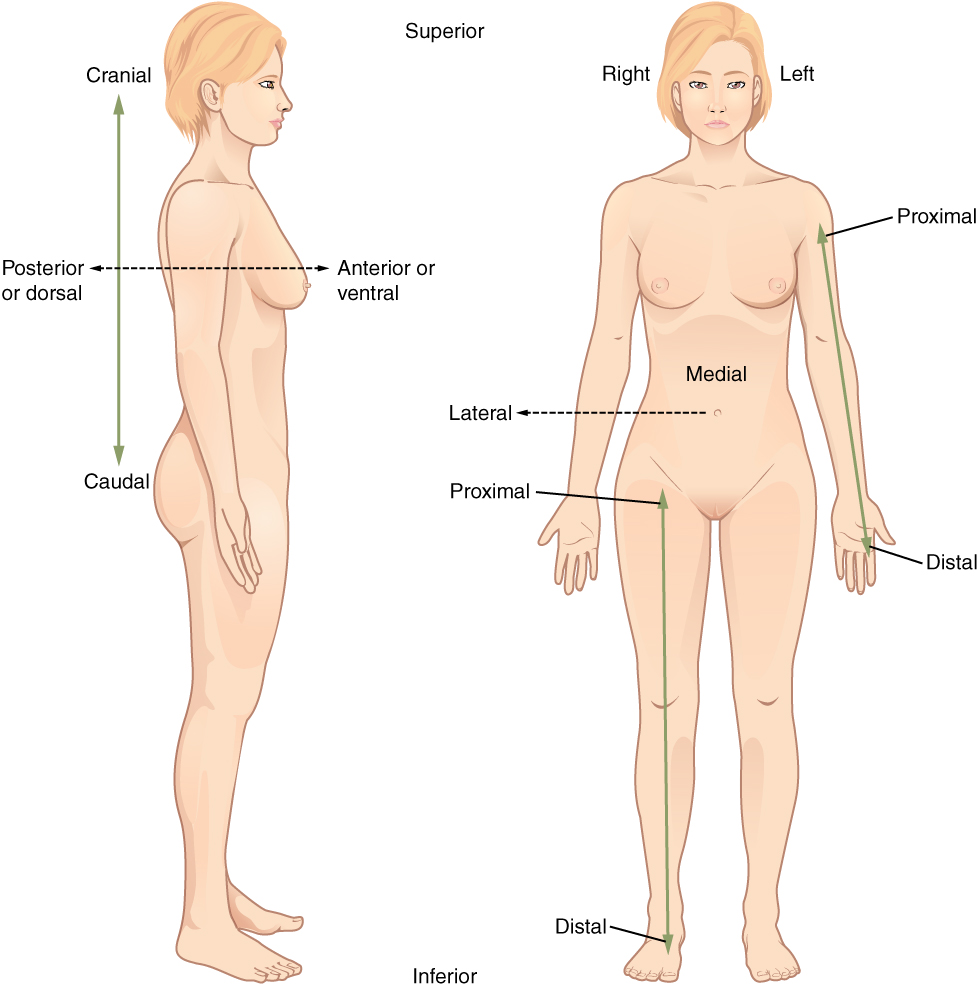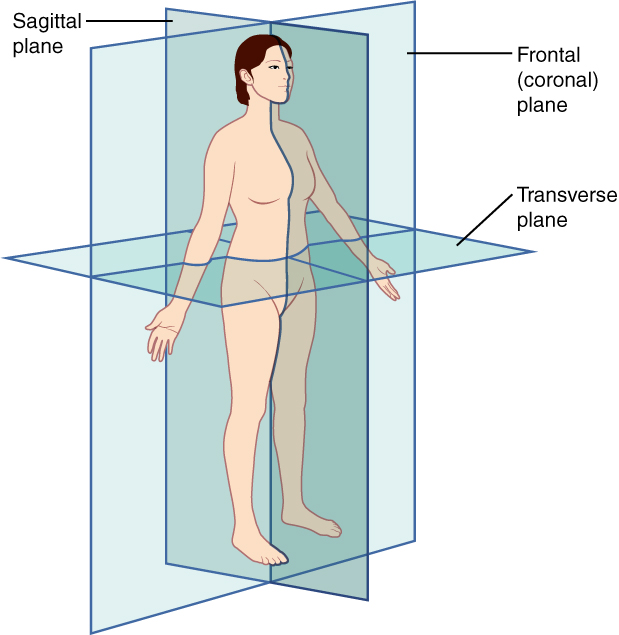Module 0 (Part II): Introduction to Anatomy
Learning Objectives:
By the end of this portion of Module 0, students will be able to:
- Describe anatomical position and properly use anatomical directional terminology with respect to that position.
Terms to Know
|
Terms of Direction
|
Positions of Reference
Anatomical Planes
|
This portion of Module 0 is self-study. We will not cover this information in lecture. However, we will use this terminology throughout the course, so we want you to become familiar with it now. Be sure to learn the information here during the first week of the course. This information will be covered in the second half of your Module 0 assignment.
Anatomical Terminology
Anatomists and health care providers use terminology to communicate specific information about the body, including specific names or locations of structures or medical conditions. Anatomical terms derive from ancient Greek and Latin words, and they are made up of roots, prefixes, and suffixes. The root of a term often refers to an organ, tissue, or condition, whereas the prefix or suffix often describes the root. For example, in the disorder hypertension, the prefix “hyper-” means “high” or “over,” and the root word “tension” refers to pressure, so the word “hypertension” refers to abnormally high blood pressure.
We will not test you on all of the word parts in the last three pages of the Glossary of Terms, but it may be helpful for you to learn these word parts throughout the course. As you learn a new term, look up the word parts. Understanding those roots can help you understand the name of a structure, pathology, or condition. We will ask you to learn the terms on this page, also on the second page of the Glossary of Terms. You will learn the regional terms on the first page of the Glossary as we get to those regions throughout the course.
Anatomical Position
Anatomical position is the body standing upright, with the feet at shoulder width and parallel, toes forward. The upper limbs are along each side, and the palms of the hands face forward as illustrated in (Figure). It does not matter how the body being described is oriented, the terms are used as if it is in anatomical position. For example, a scar in the “anterior (front) carpal (wrist) region” would be present on the palm side of the wrist. The term “anterior” would be used even if the hand were palm down on a table.
Orientation
A body that is lying down is described as either prone or supine. Prone describes a face-down orientation, and supine describes a face up orientation. These terms are sometimes used in describing the position of the body during specific physical examinations or surgical procedures.
Directional Terms
Directional anatomical terms are essential for describing the relative locations of different body structures (see (Figure)). For instance, a structure may be described as “inferior to” another or a tumor may be described as as “superficial to” a deeper body structure. Be sure to learn these terms early, as they will be used throughout the course. Remember that all of these terms are in reference to anatomical position.
- Anterior (or ventral): the front aspect or toward the front of the body.
- The toes are anterior to the foot.
- Posterior (or dorsal): the back aspect or toward the back of the body.
- The esophagus is posterior to the heart.
- Superior: above or higher than another part of the body.
- The thorax is superior to abdomen .
- Inferior: below or lower than another part of the body.
- The pelvis is inferior to the abdomen.
- Cranial: near or towards the head.
- The cervical spine is cranial to the thoracic spine.
- Rostral: near or towards the nose.
- The frontal lobe of the brain is rostral to the occipital lobe (posterior portion) of the brain.
- Caudal: near or toward the tail (in humans, the coccyx, or lowest part of the spinal column).
- The lumbar spine is caudal to the thoracic spine.
- Lateral: the side or toward the side of the body.
- The thumb is lateral to the digits (fingers).
- Medial: the middle or toward the middle of the body.
- The clavicle (collarbone) is medial to the glenohumeral joint (shoulder).
- Proximal: a position in a limb that is nearer to the point of attachment or the trunk of the body.
- The arm is proximal to the forearm.
- Distal: a position in a limb that is farther from the point of attachment or the trunk of the body.
- The wrist is distal to the elbow.
- Superficial: a position closer to the surface of the body.
- The skin is superficial to the bones.
- Deep: a position farther from the surface of the body.
- The brain is deep to the skull.

Body Planes
A plane is an imaginary two-dimensional surface that passes through the body. These planes can be used to describe the orientation of body movements. Medical imaging, such as MRI and CT scans are also taken in these planes. There are three planes commonly referred to in anatomy and medicine, as illustrated in (Figure).
- Sagittal plane: divides the body or an organ vertically into right and left sides. If this vertical plane runs directly down the middle of the body, it is called the midsagittal or median plane.
- Coronal or Frontal plane: divides the body or an organ into an anterior (front) portion and a posterior (rear) portion.
- Transverse or Horizontal plane: divides the body or organ horizontally into upper and lower portions.


